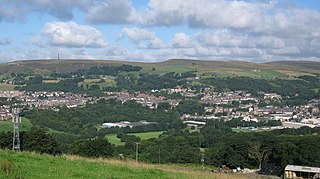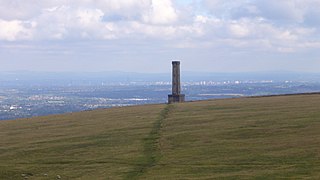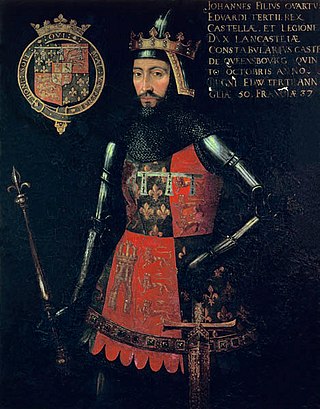
Bury is a market town on the River Irwell in the Metropolitan Borough of Bury, Greater Manchester, England. which had a population of 81,101 in 2021 while the wider borough had a population of 193,846.

Rochdale is a town in Greater Manchester, England, and the administrative centre of the Metropolitan Borough of Rochdale. In the 2021 census the town had a population of 111,261, compared to 223,773 for the wider borough. Rochdale is in the foothills of the South Pennines and lies in the dale (valley) of the River Roch, 5 miles (8 km) northwest of Oldham, and 10 miles (16 km) northeast of Manchester.

Whalley is a large village and civil parish in the Ribble Valley on the banks of the River Calder in Lancashire, England. It is overlooked by Whalley Nab, a large wooded hill over the river from the village. The population of the civil parish was 2,645 at the census of 2001, and increased to 3,629 at the census of 2011.

Haslingden is a town in Rossendale, Lancashire, England. It is 16 miles (26 km) north of Manchester. The name means 'valley of the hazels' or 'valley growing with hazels'. At the time of the 2011 census the town had a population of 15,969. The town is surrounded by high moorland; 370 m (1215 ft) to the north; 396 m (1300 ft) Cribden to the east; 418 m (1372 ft) Bull Hill to the south.

Heywood is a town in the Metropolitan Borough of Rochdale, Greater Manchester, England, in the historic county of Lancashire. It had a population of 28,205 at the 2011 Census. The town lies on the south bank of the River Roch, 2 miles (3.2 km) east of Bury, 4 miles (6.4 km) southwest of Rochdale, and 8 miles (12.9 km) north of Manchester. Middleton lies to the south, whilst to the north is the Cheesden Valley, open moorland, and the Pennines. Heywood's nickname is Monkey Town.

Ramsbottom is a market town in the Metropolitan Borough of Bury, Greater Manchester, England. The population at the 2011 census was 17,872.

Whalley Range is an area of Manchester, England; it is located about 2 miles (3.2 km) south-west of the city centre. The population at the 2011 census was 15,430. Historically in Lancashire, it was one of the earliest of the city's suburbs, built by local businessman Samuel Brooks.

The Peel Monument at Ramsbottom, Lancashire, England, is one of two monuments in the area erected in memory of Prime Minister and founder of the police force Robert Peel, who was born in Bury. It is on Harcles Hill near Ramsbottom, 1100 feet above sea level. Because of its proximity to the village of Holcombe, Harcles Hill is more commonly known as Holcombe Hill and the monument as Holcombe or Peel Tower.

Holcombe is a village in Ramsbottom ward, Metropolitan Borough of Bury, in Greater Manchester, England. It is situated south of Haslingden, east of Edgworth, west of Ramsbottom, and north of Tottington. The name comes from the Celtic cwm meaning valley, and the Old English hol, meaning deep or hollow.

Affetside is a village in Greater Manchester, England. Historically in Lancashire, it is in the Tottington ward of Bury Metropolitan Borough Council and the Bury North parliamentary constituency, in the West Pennine Moors.

Snake Pass is a hill pass in the Derbyshire section of the Peak District, crossing the Pennines between Glossop and the Ladybower Reservoir at Ashopton. The road was engineered by Thomas Telford and opened in 1821. The pass carries the A57 road between Manchester and Sheffield, but it is no longer the main signposted route between those two cities, with traffic instead directed through the Woodhead Pass to the north.

Helmshore is a village in the Rossendale Valley, Lancashire, England, south of Haslingden between the A56 and the B6235, 16 miles (26 km) north of Manchester. The population at the 2011 census was 5,805. The housing in Helmshore is mixed, with some two-up, two-down terraces, top-and-bottom houses and a few surviving back-to-back cottages. Between the 1970s and 2020 new housing estates have proliferated.

The High Sheriff of Lancashire is an ancient office, now largely ceremonial, granted to Lancashire, a county in North West England. High Shrievalties are the oldest secular titles under the Crown, in England and Wales. The High Sheriff of Lancashire is the representative of the monarch in the county, and is the "Keeper of The King's Peace" in the county, executing judgements of the High Court through an Under Sheriff.
The 1901–02 Northern Rugby Football Union season was the seventh season of rugby league football run by England's Northern Rugby Football Union. A number of off-season changes made this season different from preceding ones. In June 1901 fourteen leading clubs from both Lancashire and Yorkshire resigned from their respective County Championships to form a new Northern Rugby Football League.

The British Muslim Heritage Centre, formerly the GMB National College, College Road, Whalley Range, Manchester, England, is an early Gothic Revival building. The centre was designated a Grade II* listed building on 3 October 1974.
Heywood F.C. was an English association football club based in Heywood, Lancashire. The club was a founder member of the Lancashire League in 1889. In the 1891–92 season, Heywood made their first appearance in the FA Cup, reaching the Second Qualifying Round. They left the Lancashire League in 1892 after finishing bottom of the table with only one win from 22 matches. The club then folded and were re-formed 5 years later in 1897, mainly from the recently folded Heywood Rovers setup.

Norma Whalley was an Australian theatre and film actress active in the United States and Britain.
The Lancashire Militia was an auxiliary military force in Lancashire in North West England. From their formal organisation as Trained Bands in 1558 and their service in the Williamite War in Ireland and against the Jacobite Risings, the Militia regiments of Lancashire served during times of international tension and all of Britain's major wars. They provided internal security and home defence but sometimes operated further afield, including Ireland and the Mediterranean, relieving regular troops from routine garrison duties, and acting as a source of trained officers and men for the Regular Army. All the infantry battalions went on active service during the Second Boer War and all served as Special Reserve training units in World War I, with one battalion seeing considerable action on the Western Front. After 1921 the militia had only a shadowy existence until its final abolition in 1953.
The 1st Royal Lancashire Militia (The Duke of Lancaster's Own) was an auxiliary regiment raised in the county of Lancashire in North West England during the 17th Century. Primarily intended for home defence, it saw active service in Ireland under King William III, as well as against the Jacobite Risings of 1715 and 1745. It spent long periods on defence duties during the wars of the 18th Century and early 19th Century, and was stationed on the Ionian Islands during the Crimean War. It later became part of the King's Own (Royal Lancaster Regiment) and saw active service in the Second Boer War. After its conversion to the Special Reserve under the Haldane Reforms, it supplied reinforcements to the fighting battalions during World War I. After a shadowy postwar existence the unit was finally disbanded in 1953.

H. E. and A. Bown was an architectural practice in Harrogate, North Riding of Yorkshire, England, in the 19th and early 20th centuries. Its two partners were Henry Edwin Bown who started the business and died at the age of 36, and his brother Arthur Bown, who carried on the business until he retired in 1911.






















